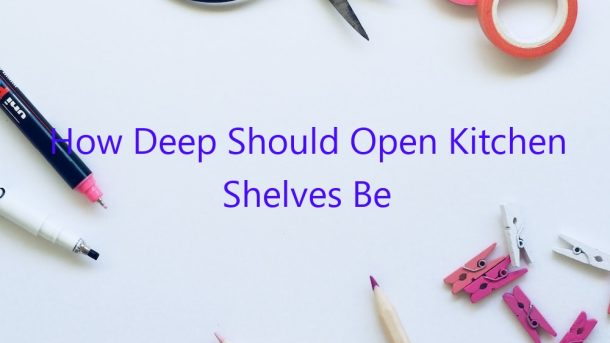Open kitchen shelves are all the rage these days and for good reason – they can make a small space feel larger and they’re a great way to show off your pretty dishes and accessories. But one question that often comes up is how deep the shelves should be.
The answer to this question depends on a few factors, including the items you plan to store on the shelves and the height of the items. Generally, it’s a good idea to have the shelves at least six inches deep, but if you have taller items, you may need to go a bit deeper.
If you’re using the shelves to store plates, glasses and other items that are six inches or shorter, six inches should be plenty. However, if you’re using the shelves to store taller items, such as bottles or jars, you’ll want to go a bit deeper to make sure they fit.
In general, it’s a good idea to measure the height of the items you plan to store on the shelves and then add an inch or two to that measurement to determine the ideal depth. This will give you plenty of space to store everything without things feeling too crowded.
Of course, if you’re not sure how deep your shelves should be, you can always opt for a deeper depth and then adjust as needed. Just be sure to leave enough space between the shelves for you to comfortably access the items on the back row.
Ultimately, the depth of your open kitchen shelves is up to you, but following these tips should help you create a space that’s both functional and beautiful.
Contents
How deep should a kitchen shelf be?
How deep should a kitchen shelf be? This is a question that many homeowners may ask themselves when remodeling their kitchen. The answer to this question will depend on a variety of factors, including the size of the kitchen, the items that will be stored on the shelf, and the height of the person who will be using it.
In general, kitchen shelves should be at least 12 inches deep in order to provide enough space for storing pots, pans, and other large kitchen items. If the shelf is deeper than 12 inches, it will be easier to store larger items and to organize the kitchen in a more efficient manner. However, it is important to note that deeper shelves will take up more space in the kitchen, so homeowners should carefully consider their needs before making a final decision.
Another factor that homeowners should consider when determining the depth of their kitchen shelves is the height of the person who will be using them. If the shelves are too deep, shorter individuals may have difficulty reaching the items at the back of the shelf. In this case, it may be necessary to install shelves that are shallower than 12 inches.
Ultimately, the depth of a kitchen shelf should be based on the specific needs of the homeowner. However, in most cases, 12 inches is a good depth to aim for.
How big should open kitchen shelves be?
How big should open kitchen shelves be?
This is a question that many homeowners have when designing their kitchen. The answer to this question depends on your needs and the amount of space you have in your kitchen.
If you are looking for a way to maximize storage space in your kitchen, then you should consider opting for large open kitchen shelves. These shelves can be as big or as small as you need them to be, and they can be used to store a variety of items, including pots and pans, plates, glasses, and utensils.
If you have a small kitchen, then you may want to consider opting for smaller open kitchen shelves. These shelves can still be used to store a variety of items, but they will take up less space in your kitchen.
Ultimately, the size of your open kitchen shelves will depend on your needs and the amount of space you have in your kitchen. If you are unsure of what size shelves to choose, then you should consult with a professional designer.
Are open shelves in kitchen a good idea?
Open shelves in the kitchen come with pros and cons. There are many factors to consider before deciding if open shelves are a good idea for your kitchen.
The main pro of open shelves is that they can make a small kitchen feel larger. They also add visual interest and can be a great way to show off your colorful dishes and pretty china.
One of the main cons of open shelves is that they can be difficult to keep clean. Everything on display is also at risk of being knocked off or spilled on. If you have small children or pets, open shelves may not be the best option for you.
Ultimately, the decision of whether or not to install open shelves in your kitchen is a personal one. Consider the pros and cons carefully before making a decision.
What is a good depth for floating shelves?
When it comes to floating shelves, depth is an important consideration. You want to make sure that the shelves are deep enough to hold your items securely, but not so deep that they become difficult to reach.
Most floating shelves are between six and eight inches deep, which is generally a good depth. If you have smaller items that you want to display, you may want to go with a shelf that is six inches deep. If you are going to be using the shelves to store larger items, you may want to go with a shelf that is eight inches deep.
Keep in mind that the depth of the shelves will also depend on the type of wall that you are using them on. If you are using them on a plaster wall, they will need to be deeper than if you are using them on a drywall wall.
When choosing the depth of your floating shelves, make sure to keep your needs and the type of wall in mind.
How much space should be between open shelves?
There is no definitive answer to the question of how much space should be between open shelves, as it will depend on the specific layout and the items being stored on the shelves. However, in general, there should be enough space between the shelves to allow for easy access to the items stored on them.
If the shelves are too close together, it can be difficult to access the items on the bottom shelves, and if they are too far apart, it can be difficult to keep the shelves tidy. Additionally, it is important to consider the size of the items being stored on the shelves. Larger items may need more space between the shelves to allow for proper airflow.
In general, it is a good idea to leave at least six inches of space between the shelves. However, if you are storing large items, you may need to leave more space between the shelves.
How deep are floating shelves in a kitchen?
When it comes to kitchen storage, floating shelves are a popular option. They’re easy to install and can be used to create a unique look in your kitchen. But how deep should your floating shelves be?
Most floating shelves are around six to eight inches deep, but you can find shelves that are deeper or shallower if you need them. If you’re using your shelves to store dishes, you’ll want to make sure they’re deep enough to hold your largest dishes. If you’re using them to store other items, you’ll need to decide what size items you want to store and choose a shelf depth that will accommodate them.
If you’re not sure what depth of shelf to choose, it’s a good idea to measure the height of your kitchen cabinets and choose a shelf depth that is equal to or less than that. This will ensure that your shelves are not too deep and will be easy to use.
Ultimately, the depth of your floating shelves is up to you. But knowing what to look for can help you choose the right depth for your needs.
How far apart should open shelves be?
How far apart should open shelves be?
That depends on the size of the items you plan to place on the shelves. If you’re using small books, they can be placed closer together. If you’re using larger items, they will need to be spaced further apart.
In general, it’s a good idea to leave at least six inches of space between each item on an open shelf. This will give you enough room to reach in and grab what you need without knocking anything else off the shelf.
If you have a lot of items to store on your shelves, it might be a good idea to use a shelving unit with adjustable shelves. This will allow you to customize the spacing to fit your specific needs.




